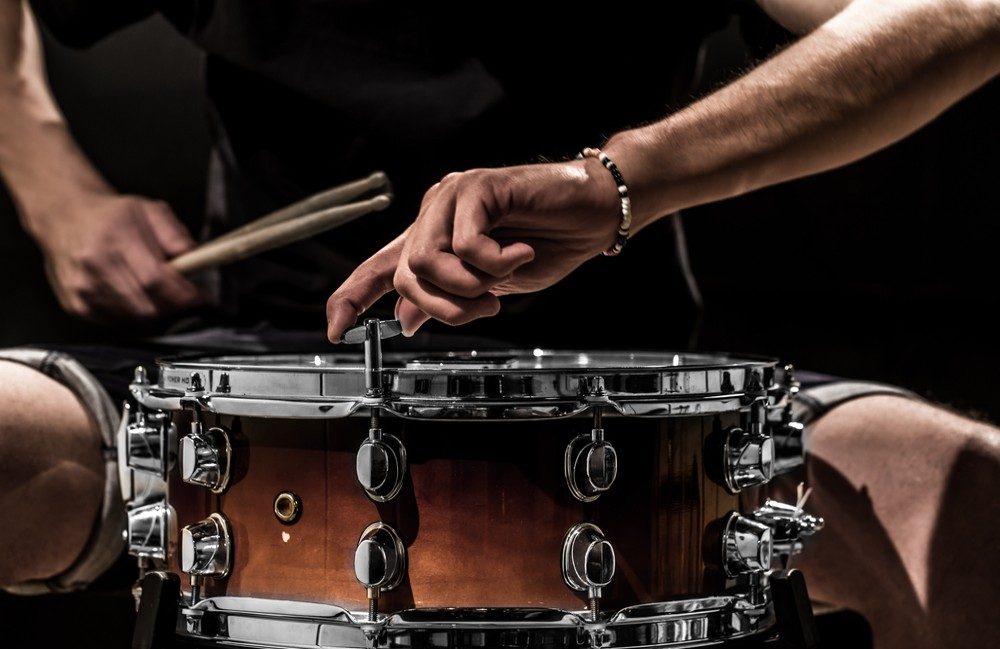Snare drums have thin metal wires, called “snares,” that strike the resonant head and themselves when struck. When struck, this percussion instrument produces a sharp staccato sound. It’s that “crack” many people hear when the drummer hits the musical instrument.
You need to learn the proper methods of striking a snare drum to create a pleasant auditory experience. Here are some essential things to consider in order to use snare drums properly.
The Anatomy of a Snare Drum
Studying the anatomy of a snare drum allows you to maintain, modify, and repair the musical instrument. Fine-tune specific parts to get that ideal-sounding “snap” with each pound of your drumsticks. Also, identifying these elements can help you fix broken or damaged pieces to avoid expensive replacement fees.
Here are the essential parts of a snare drum, along with a brief description for each component:
- Shell – the snare drum’s body
- Rims/ Hoops – the part that tightens the drumhead
- Lugs – This part houses the tension rods.
- Tension Rods/Bolts – Drummers adjust this component to get the desired sound from the drumhead.
- Snare Wires – thin, delicate strands that help give the drum a bright sound
- Strainer – a case to hold the snare wires against the side of the snare head
- Snare Beds – allows the wires to stay flat against the snare head
- Snare Head – Also called the resonant head, this significant component is underneath the musical instrument.
- Batter Head – the top head of the snare drum
Albeit the components above are essential, you can also install add-ons to your snare drum based on your preferred performance. You have the option to add extra heads, tension rods, cases, and muffling materials.
This guide to snare drums can help you check the different models available. Consider scanning through each item to get an idea of how your instrument should look and sound.
Sizes
Snare drums come in different sizes, but these features are more than aesthetic characteristics. You may find a nearly endless supply of varying snare drum sizes on the market. Manufacturers create different combinations of depths and diameters for their products. These varying dimensions help shape the sound of the musical instrument.
Still, you can follow a standard set of figures to help you find the right-sounding drum to use. First, check the depth of the instrument. It’ll have a sound profile of:
- Piccolo – if the bottom is between 3 to 4.5 inches.
- Standard – if the depth is between 4 to 6.5 inches.
- Deep – if the depth is between 7 to 10 inches.
Next, check the diameter of the snare drum. It should have an audio profile of:
- Popcorn – if the diameter is 10 inches.
- Soprano – if the diameter is 12 to 13 inches.
- Standard – if the diameter is 14 inches.
If you’re new to using snare drums, you might not be familiar with the musical jargon. Here are some examples to get you acquainted with the terms:
- You can produce a “fat” sound if you use a deep snare.
- Conversely, the drum may provide a louder “crack” if you use a shallow snare.
Materials
Buying a drum set means you should also consider the materials used in its production. The material used can play a critical role in delivering their audio outputs. While manufacturers can use different materials, you may find three common constituents from snare drums on the market. These materials are:
- Metal – This material creates bright tones. It also helps sustain the drum’s beat longer than other materials.
- Acrylic – Music enthusiasts who prefer the rock and funk genres might consider using acrylic snare drums. This material helps the instrument produce “fatter” sounds.
- Wood – Drum manufacturers might use different wooden materials like beech, maple, or oak. These wood variations might produce slight differences regarding the audio performance of varying snare drums. However, wooden snare drums might be an ideal choice for musical pieces focusing on bass and mids.
Tuning the Drum
Aside from learning the anatomy of the drum, and checking its dimensions and materials, you also need to know how to tune the snare. Many musical instruments require fine-tuning to help you get the desired audio performance. Many drummers spend time tuning their primary instruments to get to that “sweet spot.”
Know that there are three different tension levels: loose, tight, and medium. Next, you can use three different tuning combinations, which are:
- Bottom head loose and top head tight
- Bottom head tight and top head loose
- Both heads with equal tension
After deciding on the combination, you can start tuning the drum. Push the resonant head downward by turning the snare wires away. The head should snap back to its original place while tuning this component. Also, take note of the wires as these elements produce the distinctive “crack” each time they slap to the resonant head.
Furthermore, keep in mind there’ll be less air resistance when the resistance head is looser. Be cautious of over-tensioning the head because the wires might break. Don’t be afraid to spend time tuning your snare drum to make it perform the best during gigs.
Drumstick Grip
The way you hold the drumsticks while you beat the snare drum presents different audio outputs. If you’re starting as a snare drummer, you might find gripping the drumsticks a challenge. Know that there are two grip types you can choose:
- Traditional Grip
Start holding one of the drumsticks with your right palm facing down. The stick should be about two inches from its “butt.” Next, your left hand should hold the stick by placing the device between your middle and ring fingers. The stick should rest on the cuticle of your ring finger. The other fingers of your left hand will support the control as you beat your snare drum using an “up-to-in” motion.
- Matched Grip
Hold both drumsticks the same way you’d clasp a stick using the traditional grip with your right hand. Next, the pivot point or fulcrum should be in between your index and middle fingers, along with your thumb. Don’t grip the drumsticks too hard. Have a slightly loose grip to present clarity of tone while preventing injury.
Learning to Play
Different drum musicians may have different preferences in music. You might be in a percussion band, or you’re part of a group of rock artists. Your play style can reflect your tastes in music, so you need to find your unique audio tastes.
You might be a beginner drum player, or you’re practicing for a big event. Nonetheless, consider practicing to improve your skills and talents in playing snare drums.
- Practicing Rudiments
Perhaps, you might consider practicing rudiments, which are the essential steps to playing the musical instrument. Rudiments are akin to a drummer’s alphabet. While you’re learning, pay close attention to each rudiment’s skeleton. This frame is the rudiment’s most basic form. Think of it as the dictionary form of slang words.

For example, you can find a skeleton of a five-stroke roll to be four eighth notes. Master these notes to add rolls and accents to make your drum-playing unique. Also, consider using rudiments as warm-ups before performing; these “musical alphabets” allow you to practice your forearms, hands, and wrists for the main event.
- Exercise Snare Drum Rolls
Drum rolls can become an essential element to percussionists. Several approaches exist to developing your snare drum-rolling technique. You can use:
- Rebound Strokes
- Bounce Strokes
- Fulcrum Exercises
- Double Bounce Rolls
- Closed Rolls
One of the main advantages of practicing rolls is that you can do it for every piece of the drum set. You can even practice your drum rolls on cymbals. It might look simple, but it requires patience to master.
- Playing the Snare Drum Fast
Many new drummers like to play the snare drum as fast as they could. But pounding the drum with your drumsticks needs a lot of work. Fast playing is the result of repetitive practice. Don’t forget to put in the right mindset, as well. Don’t stop practicing to reach your goal of playing your snare drum as fast as you can.
Thankfully, plenty of drum exercises exist that can help improve your unique technique. But know that the core elements are accuracy, repetition, and a continuing increase in tempo over time. The result of following these factors will allow you to play your snare drum with excellent precision and speed.
Maintaining Your Snare Drum
Your snare drum will only sound as good as you want with proper maintenance. Failure to maintain the efficacy of your percussion instrument may lead to damages and breaks. You can keep the integrity and beauty of your snare drum by using:
- Drum keys for tension adjustments
- Fine-Grit sandpaper to remove splinters and even out dents
- Steel wool to remove fine rust on metal pieces
- Lubricant to let the stand slide smoothly during adjustments
- Paraffin wax to help seal the drum head to its edge
Final Thoughts
Consider these factors to become a better snare drummer, regardless of your current skill level in playing snare drums. As a beginner, learn as much as you can from this post to give your drum-playing venture an excellent start. If you’re already an expert, consider these tips as a refresher course.









